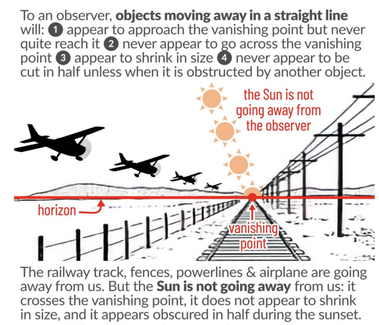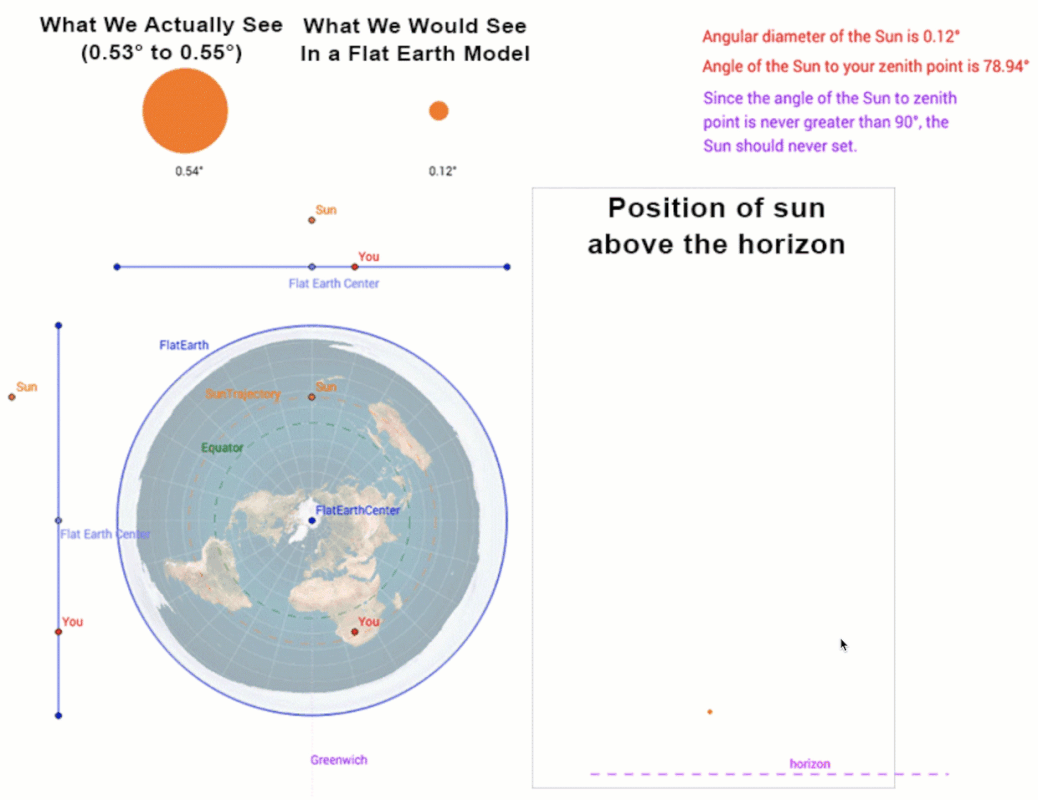Flat Earthers Perspective (Flerspective)
Some Flat Earthers complain that Globers don't take perspective correctly into account in their calculations of curvature drop or hidden height. They claim that the calculations derived from orthographic views can not produce the correct results, because in orthographic views there is no perspective.
Their thinking comes from Samuel Rowbotham who claims that objects in the distance are not hidden from bottom up by earth curvature, but is an optical illusion caused by the resolution limit of the eye. Flat Earthers use images like the following to explain their perspective understanding:
This of course is not a valid orthographic representation from which the law of perspective, i.e. the calculation of angular size, can be derived, as is used in all 3D graphics software.
Some Flat Earthers complain that Globers don't take perspective correctly into account in their calculations of curvature drop or hidden height. They claim that the calculations derived from orthographic views can not produce the correct results, because in orthographic views there is no perspective.
Their thinking comes from Samuel Rowbotham who claims that objects in the distance are not hidden from bottom up by earth curvature, but is an optical illusion caused by the resolution limit of the eye. Flat Earthers use images like the following to explain their perspective understanding:
This of course is not a valid orthographic representation from which the law of perspective, i.e. the calculation of angular size, can be derived, as is used in all 3D graphics software.

Throughout the entire day, the angular size of the sun never changes.
This is impossible on a flat earth that has a small and local sun which it would grow (moving toward) and shrink (moving away) in size as it goes around the flat earth
Thanks to many observations using solar filter, we know that the angular size of the sun stays the same and it is also the same for the moon.
Do the math, calculate the angles, plot it out. Use 3D apps, whatever. Do it for the three examples above. Then, use suncalc.org to get the observed sunrise, local solar noon and sunset locations for the three examples above and include these observations into the same dome model. Then use the same dome model to model the angular size of the sun to match the observed size of the sun, about 30 arcminutes, all day every day
This is impossible on a flat earth that has a small and local sun which it would grow (moving toward) and shrink (moving away) in size as it goes around the flat earth
Thanks to many observations using solar filter, we know that the angular size of the sun stays the same and it is also the same for the moon.
Do the math, calculate the angles, plot it out. Use 3D apps, whatever. Do it for the three examples above. Then, use suncalc.org to get the observed sunrise, local solar noon and sunset locations for the three examples above and include these observations into the same dome model. Then use the same dome model to model the angular size of the sun to match the observed size of the sun, about 30 arcminutes, all day every day
Flat Earth Excuse: You Can't See Far through the Atmosphere
I agree that haze would, in reality, prevent viewing DIM objects many thousands of miles away. However, since the Sun should be behind those objects, we should be able to see their silhouette and we cannot. So either I shouldn't be able to see the Sun or I should be able to see a silhouette... Flat Earth fails.
We can see many hundreds of miles from high altitudes so no excuse for why I can't see mountains 500 or so miles away.
Further evidence of the Flat Earth failure here is that the horizon is very sharp and distinct from 3 feet above calm waters, it is more distant at 6 feet above the water but still very distinct, and the horizon grows further and further away as we rise up and becomes more and more hazy. So it clearly isn't hazy that is limiting our view.
I agree that haze would, in reality, prevent viewing DIM objects many thousands of miles away. However, since the Sun should be behind those objects, we should be able to see their silhouette and we cannot. So either I shouldn't be able to see the Sun or I should be able to see a silhouette... Flat Earth fails.
We can see many hundreds of miles from high altitudes so no excuse for why I can't see mountains 500 or so miles away.
Further evidence of the Flat Earth failure here is that the horizon is very sharp and distinct from 3 feet above calm waters, it is more distant at 6 feet above the water but still very distinct, and the horizon grows further and further away as we rise up and becomes more and more hazy. So it clearly isn't hazy that is limiting our view.





